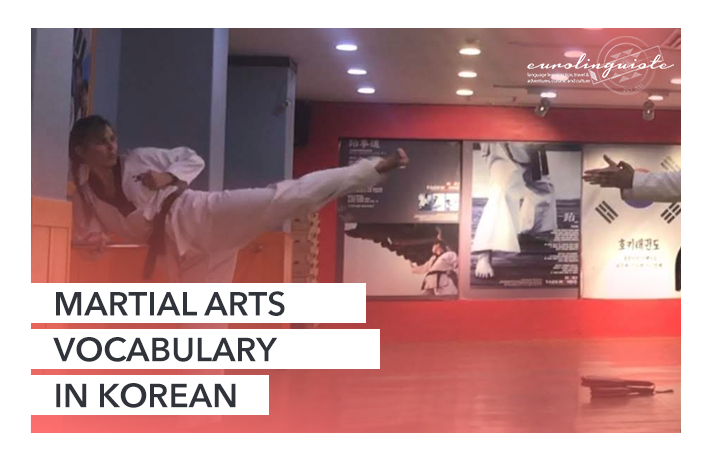Martial Arts Vocabulary in Korean: How to Talk About Taekwondo in Korean

My name is Shannon Kennedy and I'm the language lover,…
A few years back, I was really into martial arts. I practiced a branch of kung-fu, but ended up having to take a break. When I was ready to start up again, my school had closed. I didn’t start looking for a new school right away and a short break slowly became a long break.
As you know, I enjoy food, so it soon became clear that I needed to start doing some sort of exercise again to balance things out. I decided to start practicing martial arts again.
I found a new school, but it wasn’t kung-fu. Instead, they taught a combination of Japanese and Korean martial arts – hapkido, taekwondo, karate…
I went in for my evaluation to see if I could stay at the same belt level I was at in kung-fu. As the class lined up, the Master called out “차렷!” and I was like a deer in headlights. Wait, what?
As the evaluation proceeded, I quickly realized that this class wasn’t just a physical learning experience for me, but also a language learning experience. Depending on what we worked on in class, commands were given in either Japanese or Korean.
Kinesthetic learning – tying learning to movement – can be a powerful way to learn a new language and this was my first opportunity to try it out. But not following commands in class meant push-ups, and I hate push-ups. So I decided to do a bit of preparation on my own.
I found a list of taekwondo vocabulary in Korean and started working with my tutor to learn and use it my very next lesson.
If you’d like to learn Korean-specific words like these, Drops recently released several hundred Korean culture-specific words. You can become a cultural inside and learn lots of new Korean words for free with Drops.
Taekwondo Vocabulary in Korean
The Korean word Taekwondo in Hanja, or Chinese characters, is 跆拳道. This literally means “to stomp / fist / way, discipline”. It’s name is a clue to it’s style!
But before we get into specific vocabulary, first, let’s learn the basics! Here are a few branches of Korean martial arts in Korean.
Types Korean Martial Arts Vocabulary
- Martial Arts: 무술 (musul)
- Taekwondo: 태권도 (taekwondo), a martial arts focused on self-defense
- Taekkyon: 택견 (taekkyon), a martial arts that involves a focus on tripping or unbalancing your opponent
- Hapkido: 합기도 (hapkido), mostly focused on grappling with some striking
Keywords for Korean Martial Arts
And here are a few more key terms including, the Korean words for those who practice martial arts, the locations, etc.
- Master Instructor: 사범님 (sabeomnim)
- Student: 학생 (haksaeng), also 제자 (jeja) depending on the system
- Senior Student: 선배님 (seonbaenim)
- Dojo: 도장 (dochang)
- Uniform: 도복 (dobok)
- Belt: 띠 (tti)
- Belt grades (before black belt): 급 (keup)
- Belt grades (after black belt): 단 (dan)
- Kiyah!: 기합 (kihap), this is yell done by martial arts practicioners when striking or kicking to help with power)
Taekwondo Commands in Korean
- Attention: 차렷 (charyeot)
- Begin: 시작 (shijak)
- Continue: 계속 (kyesok)
- Ready: 준비 (junbi)
- Stop: 갈려 (kalryeo)
- Return: 바로 (baro), used when you need to return to face an instructor at the end of a form
- Bow: 경례 (kyeongrye)
Body Parts Used in Taekwondo in Korean
- Abdomen: 배 (bae)
- Ankle: 발목 (balmok) listen to this word
- Arm: 팔 (pal) listen to this word
- Back: 등 (deung)
- Elbow: 팔꿈치 (palggumchi) listen to this word
- Fist: 주먹 (jumeok)
- Foot: 발 (bal) listen to this word
- Ball of the foot: 압축 (apchuk)
- Blade of the foot: 발날 (balnal)
- Foot instep: 발등 (baldeung)
- Groin: 낭심 (nangshim)
- Hand: 손 (son) listen to this word
- Head: 머리 (meori) listen to this word
- Knee: 무릎 (mureup) listen to this word
- Leg: 다리 (dari) listen to this word
- Neck: 목 (mok)
- Shin: 정강이 (jeongkangi)
- Wrist: 손목 (sonmok)
Basic Taekwondo Technique Nouns in Korean
- Block: 막기 (makgi)
- Breaking: 격파 (kyeokpa)
- Dodge: 피하기 (pihagi)
- Forms: 품새 (pumsae)
- Grab: 잡기 (jabgi)
- Jump: 뛰기 (ttwigi)
- Kick: 차기 (chagi)
- Punch: 지르기 (chireugi)
- Push: 밀기 (milgi)
- Sparring: 구르기 (kureugi)
- Stance: 서기 (seogi)
- Horse Stance: 주춤서기 (suchum seogi)
- Strike: 치기 (chigi)
- Thrust: 찌르기 (jjireugi)
Basic Taekwondo Technique Verbs in Korean
- To block: 막다 (makda)
- To dodge: 피하다 (pihada)
- To grab: 잡다 (jabda)
- To jump: 뛰다 (ttwida)
- To kick: 차다 (chada), I kick is 저는 차요 (cheoneun chayo) listen to this phrase
- To punch: 지르다 (jireuda)
- To push: 밀다 (milda)
- To spar: 구르다 (kureuda)
- To stand: 서다 (seoda)
- To strike: 치다 (chida)
- To thrust: 찌르다 (jjireuda)
Directions for Taekwondo in Korean
- Back: 뒤 (dwi)
- Front: 앞 (ap)
- Side: 옆 (yeop)
Combine Directions with Techniques in Korean
By combining the direction with certain techniques, you can get more detailed vocabulary. Here are a few examples:
- Back kick: 뒤차기 (dwichagi)
- Front kick: 앞차기 (apchagi)
- Side kick: 옆차기 (yepchagi)
More Kicks in Korean
- Axe Kick: 내려차기 (naeryeo chagi)
- Crescent Kick: 반달차기 (bandal chagi)
- Hook Kick: 후려차기 (huryeo chagi)
- Push Kick: 밀어차기 (mileo chagi)
- Roundhouse Kick: 돌려차기 (dolryeo chagi)
- Front Roundhouse Kick: 앞돌려차기 (ap dolryeo chagi)
- Back Roundhouse Kick: 뒤돌려차기 (dwi dolryeo chagi)
- Scissor Kick: 가위차기 (kawi chagi)
- Spinning Hook Kick: 뒤후려차기 (dwi huryeo chagi)
- Jump Kick: 뛰어차기 (ttwieo chagi)
- Jump Front Kick: 뛰어앞차기 (ttwieo ap chagi)
- Jump Back Kick: 뛰어뒤차기 (ttwieo dwi chagi)
Punches & Strikes in Korean
To get the terms for most strikes in Korean, you combine the body part or part of the hand with the word for “strike” as in the following:
- Arc Hand Strike: 아금손 치기 (akeumson, literally “arc hand strike”
- Elbow Strike: 팔꿈치 치기 (palkkumchi chigi)
- Knife Hand Strike: 손 칼 치기 (son kal chigi)
- Palm Strike: 손바닥 치기 (sonbadak chigi)
- Back Fist: 등 주먹 (deung jumeok)
Now it’s your turn. Practice these words and expressions, and if you’re in taekwondo, see if you recognize any of them! You can also look up instructional videos for taekwondo in Korean to test your new vocabulary. This will help you instill these terms in Korean.
If you’re ready to take what you’ve learned to the next level, you can combine these terms to talk about combos in taekwondo. And you’ll get to chat about one of your hobbies – martial arts – in Korean.
What about you? Are there any taekwondo-related words or phrases you’ve picked up in Korean? Let me know!
And if you’d like to learn more words like this in Korean, check out Drops. A fun, engaging way to learn new Korean words in just 5 minutes a day. Don’t forget, you can now learn several hundred Korean culture-specific words–pick up new vocabulary to chat about everything from K-pop to traditional Korean culture.
My name is Shannon Kennedy and I'm the language lover, traveler, and foodie behind Eurolinguiste. I'm also the Head Coach of the Fluent in 3 Months Bootcamp, co-founder of Women in Language, and former Resident Polyglot at Drops.





